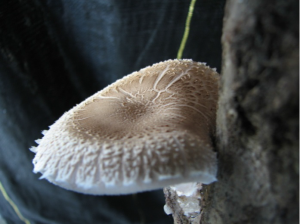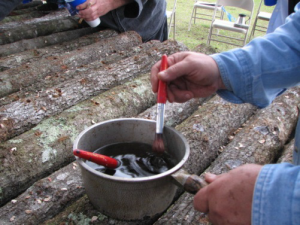
Mushrooms are an excellent low calorie food with a high fullness factor (they fill you up). But the “common” or “button” mushroom lacks natural flavor. On the other hand, shiitake mushrooms have all the benefits of button mushrooms, but offer a flavor punch and a higher fiber content. However, they are a bit more expensive. Wouldn’t it be great if you could grow mushrooms in the home garden? Growing mushrooms may be easier than you think.
Mushrooms are fungi that grow on rotting organic matter. Shiitake mushrooms are best grown on hardwood logs. Oak logs are generally used for a mushroom food source, but sweetgum, red maple, and poplar can also be used. Logs ranging from a diameter of 2” to 7” and 3’ to 4’ long are recommended. Once the logs have been cut to size, the fungus inoculation process can begin. Holes are drilled into the log and the spawn are inserted. Spawn is a fancy name for the mixture of mushroom roots (mycelium) and a growing substrate (usually made up of compacted sawdust or a wooden dowel). The plugged holes are sealed with wax. The inoculated logs should be placed in a cool, moist, well ventilated place. It can take anywhere from 6 to 18 months for the mycelium to inhabit the logs. This process is called “spawn run” or “incubation”. Mushrooms grow best within a temperature range of 50-70°F, so the fruiting process is a spring or fall event.

The recommended mushroom strains for Florida are: CS-41; CS-15; CS-24; CS-125; CS-16; CS-11; and CS-118. Favorable conditions are strain-specific, so please do some research before purchasing strains. A list of supply dealers can be found at the North American Mycological Society webpage.
Mushroom production is a fun activity, but it is extremely labor intensive. This article is just a brief summary of process. For more information on producing your own mushrooms, please visit the UF/IFAS Small Farms Mushroom Production webpage. Mushroom production is not a recommended business venture for Florida, but can be a fun hobby.
 0
0
